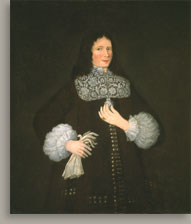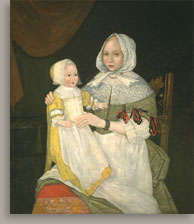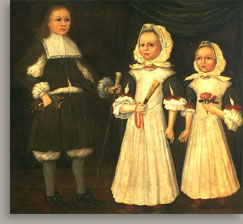| Unidentified artist Seventeenth century
Formal similarities are the most obvious commonalities among works assigned to the Freake Painter. Eight of the ten paintings are approximately the same size 42 by 36 inches (106.7 by 91.4 centimeters).3 The portraits of children the Masons and Gibbses depict the subjects full-length in a room defined simply by a black-and-white or monochromatic checkerboard floor set on a steep perspectival grid and by drapery in one of the upper corners. The adults are typically represented three-quarter length, though the portrait of Davenport is a half-length. Compositions showing a single figure are typically set off center, with the figure turned slightly toward the more open portion of the canvas. Most of the adult sitters are represented in an airless, nearly black setting, whereas Elizabeth Freake's portrait includes furniture and drapery in an ambiguous space. In the emblematic tradition of portraiture, the Freake Painter's subjects typically hold or handle one or more attributes gloves for a gentleman or older boy, a book (presumably the Bible) for a minister, and a fan, fruit, or flower for a girl. In this regard, the child Mary functions as an attribute of motherhood in Elizabeth Clarke Freake (Mrs. John Freake) and Baby Mary. While sharp contrasts of lead white and dark earth pigments are common among these paintings, the Freake Painter also used such bright colors as lead-tin yellow, vermillion, red lake, and terre verte.4 The Elizabethan style of the Freake Painter emphasized the linear depiction of forms and surface ornamentation, resulting in a deliberately flat and decorative style. Such stylization was employed in medieval Europe for religious icons and manuscript illuminations and in the sixteenth and seventeenth centuries for miniatures and life-size oil portraits of figures of authority, including royalty, the aristocracy, and members of the economic elite. While the word limner has been used to characterize artists working in this style, particularly the "Freake Limner," art historian Jonathan Fairbanks argues that that term was reserved in the seventeenth century for miniaturists.5 Noted British proponents of this style include Nicholas Hilliard (1547–1619), whose treatise on art concisely summarizes a basic aesthetic assumption shared with the Freake Painter: "Forget not therefore that the principal part of painting or drawing after the life consisteth in the truth of the line . . . for the line without shadow showeth all to a good judgment, but shadow without line showeth nothing." Hilliard advised artists to avoid harsh chiaroscuro because "great shadow is a great sign in a picture after the life of an ill cause, and showeth plainly that either the drawer has no good sight to discern his shadows except they were gross, or had a bad light to draw in."6 The style advocated by Hilliard had international origins, including the example set earlier by Hans Holbein the Younger (1497–1543), the court painter to Henry VIII. Holbein was a German painter who had worked in Switzerland and France before coming to England in 1532. The Elizabethan style of Hilliard and such contemporaries as Robert Peake the Elder (active 1576–1626) remained current in England well into the seventeenth century. With the arrival of Anthony Van Dyck (1599–1641) at the court of Charles I in 1632, British portraiture took a turn toward the baroque that changed the course of British and American painting in the seventeenth and eighteenth centuries. The linear Elizabethan style was still practiced, however, in London and the provinces as late as the 1680s, though it was increasingly a residual rather than dominant style.7 The Elizabethan style was probably communicated from England to New England in a number of ways. Several of the seventeenth-century sitters, including John Freake (1631–1675) and John Rawson (1615–1693), were born in England and emigrated to Boston as adults. They would have brought with them artistic expectations formed in the 1630s and 1640s, when the Elizabethan style was actively practiced. Texts were another source for aesthetic information transmitted transatlantically. In Boston Increase and Cotton Mather owned a copy of John Bate's Mysteries of Nature and Art (1635), which was based largely on the English mannerist treatise A Tract Containing the Artes of Curious Painting, Carving, Building . . . (1598) by Richard Haydocke, who borrowed from Hilliard and the Italian writer Giovanni Paolo Lomazzo.8 Additionally, artists taught to paint in England imported the Elizabethan style and ideas about art directly.9 Understanding of the Freake Painter's origins and level of training have changed considerably since his paintings first earned scholarly attention. In 1923 the director of the Worcester Art Museum, Raymond Henniker-Heaton, wrote that the Freake Painter lacked "mechanical skill" and "academic training" but made up for it with "creative ability."10 A decade later, the next director of the museum, Francis Henry Taylor, proposed that the portraits' "marked similarity to many of the Jansenist portraits in the Loire valley" likely made the Freake Painter a Frenchman.11 At about the same time the historian of American art Virgil Barker posited theories that the Freake and related portraits were done by an itinerant artist either moving south from Quebec or north from New York.12 In 1935 Louisa Dresser, a curator at Worcester, stated categorically, "Early painting in New England was, in fact, a provincial development of English painting of the sixteenth and seventeenth centuries, a condition which the cultural ties binding the colony to the mother country made inevitable. The unknown painters were probably, in some cases, obscure English artists who came to this country with a style fully formed under the influence of the more important painters of the period."13 The French and Dutch styles discerned by previous scholars in seventeenth-century New England paintings, Dresser added, may have been vestigial influences from artists who traveled to England from the Continent. While Dresser's theory has gained nearly general acceptance, a conflicting strain of thought has insisted that the Freake paintings are "among the finest of 'American primitives'" and stand as the roots of nineteenth-century American folk painting.14 Augustine Clement (about 1600–1674) is one such artist who trained in England and emigrated to New England, though no works can be assigned to him with certainty.15 Clement was born near Reading, Berkshire, England, and apprenticed to the decorative and heraldic painters Jonathan Miller and Edward Newman. Clement emigrated to Massachusetts in 1635, settling in Dorchester and then Boston. While Clement was in Boston in time to paint most of the paintings attributed to the Freake Painter, he could not have painted Elizabeth Clarke Freake (Mrs. John Freake) and Baby Mary. An inscription on that portrait gives the age of Mary as six months. Since she was born May 6, 1674, the painting was probably completed in November or early December 1674. Clement died October 1, 1674.16 His son, however, was also an artist. Samuel Clement (about 1635–1678) is identified in contemporary documents as a painter and a "painter-stainer," and his probate inventory listed "colouring Stuffe for painting" worth five pounds among his possessions.17 Though Samuel Clement lived in the North End of Boston near the Freakes and other sitters thought to have been painted by the same hand, the case for him as the Freake Painter remains circumstantial and speculative since there were about fourteen artists working in Boston in the seventeenth century.18 One remaining evaluative question is whether the Elizabethan style represented an outmoded style or a current one when the Freake portraits were painted. Scholars including Dresser and more recently Fairbanks traced the style up to the 1630s in England. Dresser concluded, "These [the Freakes] are primarily costume pictures and are definitely retardataire. For their origins one must look not to the minor paintings of the 1660s or 1670s in England, already affected by new-fangled ideas of light and shade, but to the provincial painting of forty years earlier which was still in the Elizabethan tradition."19 Fairbanks proposed that the Elizabethan style remained in use until the 1670s, though his claim is weakened by using Robert Peake, who died in 1626, as his example.20 More recently, Wayne Craven has presented two drawings as evidence that the Elizabethan style remained in use in England into the 1680s, but he was unable to cite a single painting from that time, and one of the drawings he offered is by an amateur artist.21 In other words, the Elizabethan style had almost been completely replaced in England by the 1670s and soon gave way to a more volumetric style. In New England, this transition was influenced by imported engravings after Sir Peter Lely (1617–1680) and Sir Godfrey Kneller (1648–1723). Notes 12. Barker 1934, 509 (original); 53 (reprint). |


